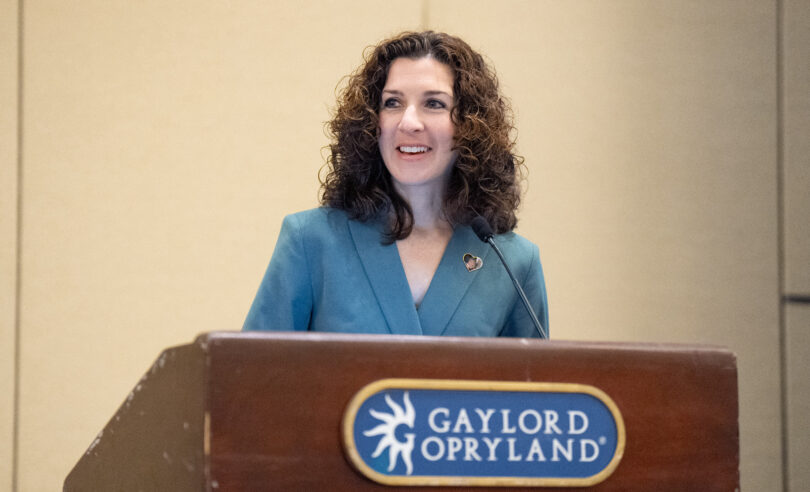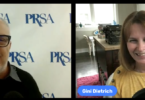Over the next few weeks, PRsay will post Q&As with several thought leaders who spoke at PRSSA’s ICON 2023 at the Gaylord Opryland Resort & Convention Center in Nashville, Tenn.
On Oct. 15, PRSSA honored Gina Laughlin with its Hall of Fame Award, which recognizes PRSSA alumni who are currently PRSA members and have made outstanding contributions to the profession.
Laughlin, a former PRSSA president, is vice president of global employee communications for Delta Air Lines. She also delivered PRSSA’s keynote address. During ICON, she talked with PRsay about Delta’s employee-first approach to internal communications and the challenges of reaching deskless employees.
What is an “employees first” approach to internal communications?
We use an employee-led approach to internal comms at Delta. It starts with a simple question: What do employees need from us? Contrast that with internal communications of a decade or so ago, which started with, “What do we want to tell our audience?”
By understanding our audience and our employees, and meeting them where they are with information they need — not just what we want them to know — we hope [that empathy] frees a little room in their attention span to continue reading [what] we would like them to be aware of.
With internal communications, how does Delta engage its deskless employees?
Engaging a remote and absentee workforce continues to be a challenge. We don’t feel like we’re quite there yet. [But it] is about meeting employees where they are and trying to find technology that enables good communication from an organization’s leadership team in [the employee’s particular] place of work. In some cases, for us, it means putting a device in the hands of an employee. We do that quite a bit with our pilots and flight attendants.
We also enable email access to files they need, or to our internet, our storytelling. We’ve seen significant increases and engagement with our communications by doing that.
We try different tactics. If employees are not able to have a device on them, perhaps for operational or safety reasons, then we try to do more face-to-face and leverage those start-of-shift briefings or end-of-shift briefings, to engage the leaders. [We also use] television screens, with a lot of video, in break rooms.
How can internal communications professionals help build trust for an organization?
Internal comms is so important to building trust and credibility and connecting employees, not only to the mission and the purpose of the organization, but also to the leaders of the organization and to each other. That’s where the real culture-building comes in, when employees feel connected to their colleagues, to their immediate leaders and to senior leaders in the C-suite. Through good PR and communications strategies across a number of channels and tactics, over time, every day, you put those chips in the bank. That ongoing storytelling that reinforces the business objectives of the company or reinforces the culture — using it for recognition, to describe and connect people to purpose.
Every day, there’s something we get to do to make an employee feel more connected. It’s that transparent communication, that connected experience that builds trust and credibility over time.
What trends in employee communications are you watching?
We are always trying to pay attention to what is happening from a technology perspective. Where can we leverage technology to help tell our stories and get our messages across a little bit easier? What are trends in stories that employees may be connecting to or reading more often or less often?
We’re trying to think about what is happening inside the organization [and what employees] may be hearing from outside the organization that could influence how we craft messages or how we tell those stories. Technology is probably the biggest one, and then watching what’s happening in the world, what’s happening in society, to make sure we’re staying attuned to messages, trends or topics that may be more relevant or less relevant on any given day.
Everyone is talking about AI. Has artificial intelligence technology had an effect on your employee communications?
As internal communicators, we support Delta employees, many of whom are directly involved in supporting our customers. Being able to provide fast and accurate, automated access to information that our customers need is going to be one of the biggest benefits [of AI]. Our ability to have that communications machine — whether it’s information that employees need to do their jobs, or that employees need to pass along to customers — could be a big benefit.
I’ll also be watching how employees — and how all of us — trust information differently. Do we trust information that comes from a machine differently than we trust information sourced from a human?
Do policy- and procedure-related, technical communications feel more accurate coming from an AI-driven apparatus? Do communications on behalf of an individual or brand feel less authentic when driven by machine learning? Those are things we’re going to be looking at in the years ahead.
Here, she talks what about what the future of employee communications looks like:
John Elsasser is PRSA’s publications director and editor-in-chief of its award-winning publication, Strategies & Tactics. He joined PRSA in 1994.
[Photo credit: jim cowsert/grapevine photo]






